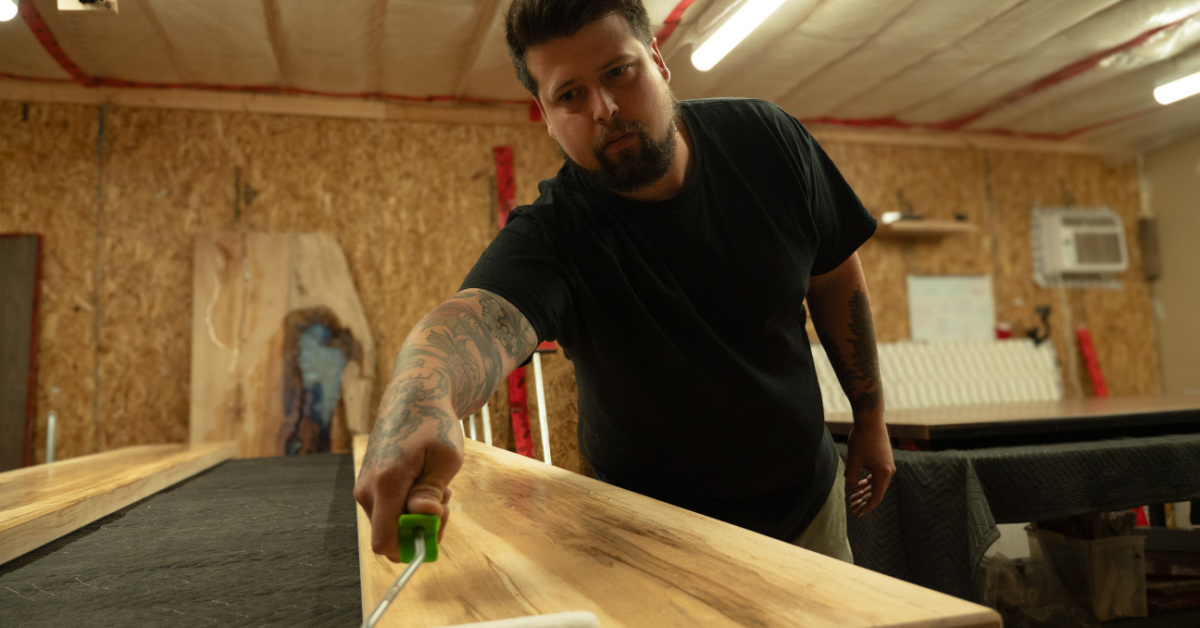The Art of Finishing: How the Right Oil Brings Wood to Life
There’s something truly magical about watching raw wood come alive under the touch of oil. That moment when dull grain transforms into shimmering texture — when a board becomes a piece of art — is at the heart of what we love most at Vinogradofff. The right finish doesn’t just protect wood; it reveals its soul.
Whether you’re crafting a live-edge table, refinishing a countertop, or adding the final touches to a handmade board, understanding the art of finishing can turn a good project into an heirloom piece. Let’s explore what makes wood oils special, how different finishes change the look and feel, and why choosing the right one matters.
Why Finishing Matters
Raw wood is beautiful, but it’s also vulnerable. Without protection, it can dry out, absorb moisture, and lose its natural character over time. Finishing acts as both armor and amplifier — it safeguards the wood while enhancing its grain, depth, and warmth.
At Vinogradofff, we often say finishing is where craftsmanship meets emotion. It’s the final step where vision meets touch — when the maker’s care is sealed into the piece.
But not all finishes are created equal. That’s where wood oils come in — natural, durable, and incredibly expressive.
The Beauty of Oil Finishes
Unlike surface coatings like polyurethane or lacquer, oils penetrate deep into the wood fibers. They nourish the material from within, bringing out a rich, natural glow that feels as good as it looks.
Oil finishes allow the wood to breathe and age gracefully. Over time, they develop a subtle patina — a visual story that evolves with every use. For makers and homeowners who value authenticity, oils are the ultimate choice.
Different Oils, Different Stories
Each oil tells a different story through texture, tone, and feel. At Vinogradofff, we carry a carefully curated selection of trusted brands — including Rubio Monocoat, Odie’s Oil, OSMO, and ICE Epoxy — each with its own unique personality and purpose.
Rubio Monocoat
A favorite among professionals, Rubio Monocoat is known for its single-coat technology. It molecularly bonds with wood fibers, offering incredible durability and water resistance — all without forming a thick film. The result? A matte, natural look that feels silky to the touch. It’s ideal for furniture, countertops, and flooring where you want color, protection, and simplicity all in one.
Odie’s Oil
Odie’s is a handcrafted blend of oils and waxes that’s 100% solvent-free. It brings warmth and depth like no other — a finish that enhances grain contrast and gives wood a hand-rubbed richness. Because it’s food-safe, Odie’s is perfect for cutting boards, charcuterie slabs, and dining tables.
OSMO
OSMO’s hardwax oils are beloved for their balance between beauty and durability. They combine the penetrating qualities of oil with the protective power of wax, creating a breathable surface that resists stains and moisture. Perfect for floors, cabinetry, and surfaces that need to stand up to daily life.
ICE Epoxy Finishing Oils
For those combining epoxy and wood, ICE Finishing Oils are engineered to bring both materials into harmony. They enhance the contrast between resin and wood, delivering a flawless, tactile finish that feels refined and contemporary.
Choosing the Right Oil for Your Project
Picking the right finish depends on how the piece will be used and the look you want to achieve.
-
For natural, matte finishes: Choose Rubio Monocoat for a clean, modern aesthetic.
-
For deep, rich tones: Odie’s Oil will bring out every detail of the grain.
-
For long-lasting protection with a soft sheen: OSMO is your go-to.
-
For resin-heavy or epoxy projects: ICE Finishing Oils provide cohesion and clarity.
No matter your choice, always test your oil on a small offcut of the same wood first. Wood species vary dramatically in color and absorption, and testing ensures you’ll get the exact tone and finish you envision.
The Finishing Touch: Technique Matters
Even the best oil won’t shine without the right technique. Start with smooth, sanded wood — ideally up to 180–220 grit — and remove all dust before applying. Use a clean cloth, sponge, or brush to work the oil into the surface, following the direction of the grain.
After applying, let the oil soak in, then buff off the excess. This step is crucial — too much residue can leave a sticky surface or uneven sheen. Depending on the product, you may need one or two coats, followed by a gentle polish to bring out the final glow.
Finishing Is an Experience
The art of finishing is more than a step in the process — it’s a ritual. It’s the quiet satisfaction of watching character emerge from within the wood. It’s the moment when craftsmanship becomes connection.
At Vinogradofff, we’ve seen time and again how the right oil transforms not only the material but the maker’s relationship with their work. Whether you’re restoring a family table or creating something entirely new, the finish is your signature — the part that tells the world you cared enough to do it right.
So next time you stand over that freshly sanded surface, take a breath and reach for the right oil. Because when wood truly comes to life, you’ll know — you’ve mastered the art of finishing.






